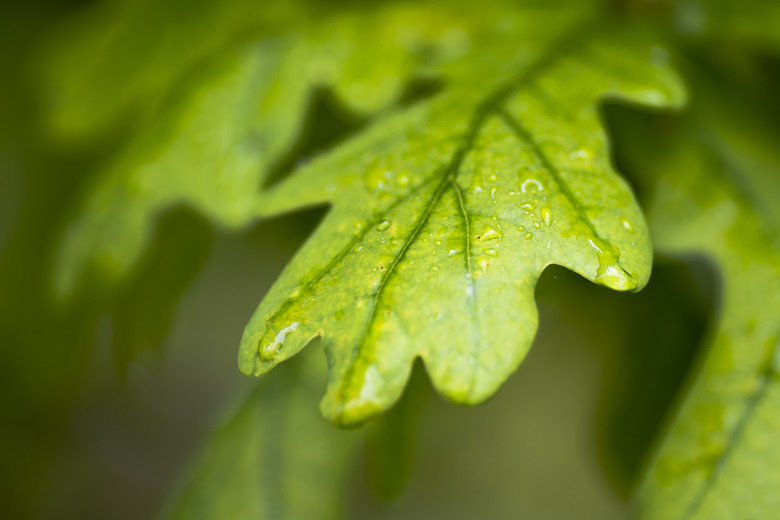How To Identify Oak Trees By The Leaf Shape
Leaf shape alone often can't provide definitive proof of an oak tree's species, except where only a few sorts of oak grow, or where a distinctively leafed kind doesn't have any lookalikes sharing its range. Oak leaves, after all, show significant variety within a given species and even on the same tree, and furthermore many types of oak sport similar-looking foliage. Nonetheless, the shape of oak leaves certainly provides important clues for species identification, useful when considered alongside other characteristics such as leaf texture, general habit and the appearance of flowers, buds, acorns and bark – and, of course, with a good field guide on hand with which to look up these features.
Oak Leaves
Oak Leaves
Some 600 species of oaks exist across a vast Northern Hemisphere range, with about 90 calling the United States – one of the global centers of oak diversity – home. Oaks claim a dizzying variety of leaf shapes and sizes: from the small, lanceolate leaves of many live oaks to the long slender ones of the appropriately named willow oak, and from the "classic" multi-lobed foliage of many white and red oaks to leaves that look more like a maple's or chestnut's, or especially eccentric leaves resembling a duck or dinosaur foot.
Many northern oaks grow larger, more lobed leaves than southern species; while northern oaks are deciduous, many southern ones are evergreen or semi-evergreen, retaining living foliage year-round or just about. Even deciduous oaks, however, often hold onto some of their dried leaves throughout the winter, so more often than not you'll have at least a few leaves in decent shape with which to try to suss out a given oak's pedigree.
It's important, though, to look at a number of leaves on a given oak to account for the often-notable variation in foliage found within one tree crown. A leaf in the dense shade of the lower canopy may be much larger and broader than one on an upper twig exposed to full sun. Leaves on a single oak may have entirely different profiles: Some may be lobed and others not; some may have toothed edges and others smooth ones. Assess as many leaves as you can to sort out the most prevalent shape.
White Oaks vs. Red Oaks
White Oaks vs. Red Oaks
Leaf shape alone frequently allows you to make a basic distinction between two major groups of oaks – white oaks and red oaks – at least when it comes to those common and widespread species with lobed leaves. In white oaks, the lobes tend to be rounded; red oaks, by contrast, show pointed lobes with bristled tips. A typical lobed red-oak leaf, therefore, looks sharper-edged or "toothier" than a lobed white-oak leaf. This general I.D. feature doesn't get you down to species level unless you cross-reference it against geographic location and other factors.
Oaks With Particularly Distinctive Leaves
Oaks With Particularly
Distinctive Leaves
A few oaks boast foliage singular enough to serve as species giveaways. For example, the maple-leaf oak – restricted to a very small, hilly range in western Arkansas and listed as endangered on the International Union for the Conservation of Nature (IUCN) Red List – does, as its name suggests, brandish deeply lobed, palmate leaves that could easily be mistaken for those of a maple but don't much resemble those of any other American oak's. The heavy, dense veins of the netleaf oak, meanwhile, distinguish this scrubby species of the American Southwest and Mexico.
Leaf Shape and an Oak's Setting
Leaf Shape and an Oak's Setting
In many cases an oak's leaf shape and its geographic location together provide a pretty good indication of species. For example, a wild-growing oak with heavily lobed leaves in the Southern Rocky Mountains or Colorado Plateau can only be the Gambel oak; in the Pacific Northwest, such a tree can only be the Garry oak (a.k.a. Oregon white oak). Even within a given geographic area, ecological setting or habitat can give you confidence in identifying certain oaks by leaf shape. A "duck-footed" oak leaf in the Deep South is probably that of a water oak if you find it in bottomland woods, and probably that of a blackjack oak if you encounter it along a dry ridgecrest.
References
- USDA Forest Service: Field Guide to Native Oak Species of Eastern North America
- Field Guide to North American Trees; Thomas S. Elias
- The Sibley Guide to Trees; David Allen Sibley
- The Ecology & Silviculture of Oaks; Paul S. Johnson et al.
- Iowa State University: Iowa's Oaks
Cite This Article
MLA
Shaw, Ethan. "How To Identify Oak Trees By The Leaf Shape" sciencing.com, https://www.sciencing.com/identify-oak-trees-leaf-shape-6365583/. 10 April 2018.
APA
Shaw, Ethan. (2018, April 10). How To Identify Oak Trees By The Leaf Shape. sciencing.com. Retrieved from https://www.sciencing.com/identify-oak-trees-leaf-shape-6365583/
Chicago
Shaw, Ethan. How To Identify Oak Trees By The Leaf Shape last modified March 24, 2022. https://www.sciencing.com/identify-oak-trees-leaf-shape-6365583/
